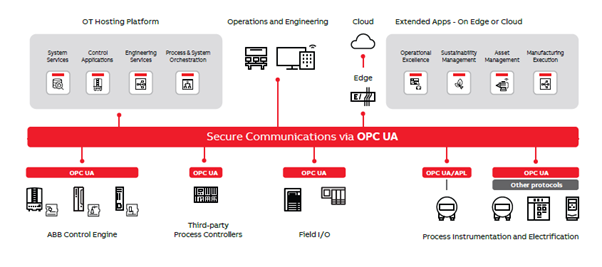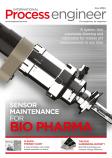
The world is changing, and today’s industrial control systems need to change with it. ABB’s Johan Björklund explains how ABB envisions the process automation systems of the future and the benefits they will deliver.
The rapid changes that have taken place on the world stage, especially since 2019, have presented a raft of challenges for industrial companies. A combination of the COVID-19 pandemic, supply chain issues, rising labour shortages, geopolitical disputes and growing pressure to minimise the impact of industrial activities on the environment are leading many process industry companies to re-think their operational models.
Distributed Control Systems (DCS) have been helping to ensure reliable, efficient, and safe performance of industrial processes for over 40 years. During this time, the technology has been refined and adapted to reflect growing requirements. With the advent of digitalisation, this refinement is now being taken one step further, with the ‘Digital DCS’ offering a raft of exciting new opportunities for maximizing productivity, collaboration and operator engagement without compromising any of the core functions of the DCS itself. Furthermore, with sustainability now a key part of the corporate agenda, the potential offered by digitalization will also help to ensure that the DCSs of the future can play a major role in helping companies to achieve their Net Zero targets.
Adaptivity for the future
Ensuring the flexibility to meet changing future requirements needs control systems that can evolve with the needs of the user, enabling them to add new functions that will make them more open, interoperable, and adaptable.
The cost and criticality of DCSs rules out replacing them whenever a new development comes along or a new function is needed. For this reason, the DCS solutions of the future must offer the ability to accommodate new user needs and opportunities presented by new technologies and solutions while continuing to deliver safe, secure, and reliable operation.
This is where a modular approach can deliver particular benefits, as elements of the process can be changed or upgraded without replacing the entire system, effectively future-proofing the DCS against new developments.
This flexibility to meet future demands will be ensured by separating the core functions of the DCS and those that are less time or process critical to create an extended automation environment that will facilitate greater collaboration between people, systems and equipment, such as that shown below.
Creating this structure is being enabled by developments that allow the expansion of the functions of the DCS without affecting the core control system itself. The NAMUR open architecture (NOA) model, for example, effectively adds a layer to the DCS that allows the addition of extra functions. By providing an open and secure environment for integrating IT components from the field up to enterprise level, NOA enables operators to extend the capabilities of their control systems to incorporate new functions like asset and device management, optimisation and planning without the time, risks or potential disruption required for changes or upgrades.
One example of this is the application of edge and Cloud computing technology, which is helping companies to realise the benefits of IIoT-enabled sensors. By using this technology, it is now possible to collect and analyse huge quantities of data across multiple parameters, and share it between individuals, departments, or different sites.
Moving non-core control system functions to a connected-yet-separate digital environment in this way will allow users’ systems to adapt more readily to changing needs. Creating a more agile, modular environment will enable faster adoption of new and innovative offerings, while existing applications can be moved to a virtualised, digitally native environment, where advanced cybersecurity tools can be deployed.
Transforming project execution
With operators facing the need to get new production units online faster, there is a need to be able to minimise the time and engineering resource needed to deploy DCS solutions. The separation of automation hardware and software engineering at the set-up stage is one way of achieving this. ABB’s Adaptive Execution approach, for example, enables multiple teams to carry out project tasks in parallel working from different locations or even in a virtualised cloud engineering environment.
By removing the time and step-dependent stages previously entailed in engineering control system hardware and software and instead enabling all work to be carried out at the same time, project delivery times can be significantly reduced, with potential time savings of anywhere between 10-40%.
Further time savings will also be able to be achieved using pre-made and pre-tested automation software modules that will already be set up with the elements required for the application and have the required interfaces needed to communicate with both other modules and the overall system.
By automating or removing many of the time-consuming tasks associated with project execution, the DCS solutions of the future will also enable engineers and technicians to operate at a higher level, allowing companies to get more from their engineering teams.
Optimising performance with data analytics
It is estimated that an average plant uses just 20% or less of the data it generates, representing a significant missed opportunity for optimising performance. To date, a major challenge for many companies has been finding ways to collect and analyse data and turn it into information that can then be relayed to the relevant person or people for action.
Digital technologies are helping to address this, providing users with AI-enabled analytics that can be combined with edge computing to analyse operational data at the point of production, opening new possibilities for improved asset management and predictive maintenance that can be used to fine-tune plant or process performance.
Another area where analysis of data using digital technologies can provide benefits is regulatory compliance. Developments such as cloud-hosted continuous emissions data analytics can be used to check the performance of multiple emissions monitoring instruments. By monitoring in real-time and comparing data on actual performance against established models, companies will be able to demonstrate and report their compliance with environmental regulations. Furthermore, with availability of emissions monitoring equipment being a key requirement of compliance, the analysis of operational data will also open new opportunities for identifying potential issues that could result in systems going offline, enabling pre-emptive action to be taken in good time.
Making new business models possible
The effective separation of hardware and software in the digital DCS offers an alternative path when it comes to upgrading to meet future challenges. Whereas specifying and purchasing hardware-based DCS systems has traditionally been a protracted and costly exercise, the new digital ecosystem allows for a totally different approach to be taken, which enables changes to be made at much less cost and at a considerably quicker pace.
Models such as Software-as-a-Service (SaaS) and Platform-as-a-service (PaaS) are now increasingly viable, significantly shortening the DCS purchasing and implementation times. Additional models such as self-service free trials and pay-as-you-use will also provide users with the freedom to choose specific applications and services that they need, with the option to discontinue using them when they are no longer required.
Together, these approaches will help to boost innovation and flexibility, helping users to find new ways to adapt their DCS to meet both their current and future business challenges.
Towards the autonomous control system
With knowledge, drain and labour shortages becoming increasingly big problems for process operators, there is a growing need for automation to help assist operators in the operation and maintenance of industrial plants.
Today’s control systems are already helping to minimise the requirement for human intervention under normal conditions in a growing variety of low-level processes. There is still the need, however, for human intervention to handle more complex and higher-level unusual decisions and tasks. It is these tasks that represent the goal for autonomous control systems in the process automation systems of the future.
AI will be the enabler for achieving this autonomy, with its pace of introduction being dictated by degrees of trust where the technology effectively proves that it can operate safely, and the tasks being handled are assessed for their suitability for automation. ABB has its own six-level taxonomy of autonomy, built around the two dimensions of the scope of the automated task and the role of the human. This taxonomy ranges from Level 0, with no autonomy, through to Level 5, where all decision-making and actions are performed completely autonomously by the system.
Bringing intelligence to the field
AI and machine learning algorithms will also be instrumental in giving engineers in the field greater intelligence that will help them to diagnose and solve process problems. Mobile access to control systems data will enable them to access data on real-time process conditions, while Augmented Reality (AR) tools will give them the ability to use virtual instruction guides and manuals to carry out repairs or share views of equipment or situations with remote subject matter experts.
A bright future for the DCS
While the limitations of their closed structure had led some to predict the demise of the DCS, the flexibility delivered by the latest generation of digital technologies, coupled with initiatives such as NOA that enable the separation of core and non-critical functions mean that the future is looking bright.
As the future advances and DCS solutions become increasingly open both in terms of their functionality and their usability, industrial operators will be presented with a growing raft of functions and opportunities that will transform the performance and sustainability of their operations.


















